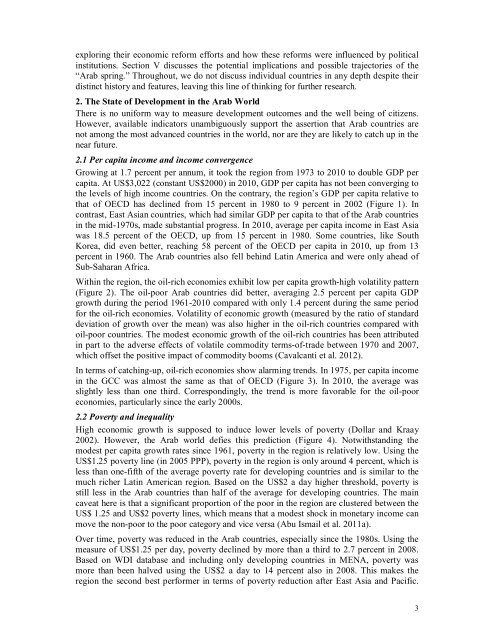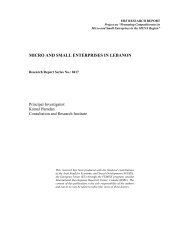the elusive quest for arab economic development
the elusive quest for arab economic development
the elusive quest for arab economic development
Create successful ePaper yourself
Turn your PDF publications into a flip-book with our unique Google optimized e-Paper software.
exploring <strong>the</strong>ir <strong>economic</strong> re<strong>for</strong>m ef<strong>for</strong>ts and how <strong>the</strong>se re<strong>for</strong>ms were influenced by politicalinstitutions. Section V discusses <strong>the</strong> potential implications and possible trajectories of <strong>the</strong>“Arab spring.” Throughout, we do not discuss individual countries in any depth despite <strong>the</strong>irdistinct history and features, leaving this line of thinking <strong>for</strong> fur<strong>the</strong>r research.2. The State of Development in <strong>the</strong> Arab WorldThere is no uni<strong>for</strong>m way to measure <strong>development</strong> outcomes and <strong>the</strong> well being of citizens.However, available indicators unambiguously support <strong>the</strong> assertion that Arab countries arenot among <strong>the</strong> most advanced countries in <strong>the</strong> world, nor are <strong>the</strong>y are likely to catch up in <strong>the</strong>near future.2.1 Per capita income and income convergenceGrowing at 1.7 percent per annum, it took <strong>the</strong> region from 1973 to 2010 to double GDP percapita. At US$3,022 (constant US$2000) in 2010, GDP per capita has not been converging to<strong>the</strong> levels of high income countries. On <strong>the</strong> contrary, <strong>the</strong> region’s GDP per capita relative tothat of OECD has declined from 15 percent in 1980 to 9 percent in 2002 (Figure 1). Incontrast, East Asian countries, which had similar GDP per capita to that of <strong>the</strong> Arab countriesin <strong>the</strong> mid-1970s, made substantial progress. In 2010, average per capita income in East Asiawas 18.5 percent of <strong>the</strong> OECD, up from 15 percent in 1980. Some countries, like SouthKorea, did even better, reaching 58 percent of <strong>the</strong> OECD per capita in 2010, up from 13percent in 1960. The Arab countries also fell behind Latin America and were only ahead ofSub-Saharan Africa.Within <strong>the</strong> region, <strong>the</strong> oil-rich economies exhibit low per capita growth-high volatility pattern(Figure 2). The oil-poor Arab countries did better, averaging 2.5 percent per capita GDPgrowth during <strong>the</strong> period 1961-2010 compared with only 1.4 percent during <strong>the</strong> same period<strong>for</strong> <strong>the</strong> oil-rich economies. Volatility of <strong>economic</strong> growth (measured by <strong>the</strong> ratio of standarddeviation of growth over <strong>the</strong> mean) was also higher in <strong>the</strong> oil-rich countries compared withoil-poor countries. The modest <strong>economic</strong> growth of <strong>the</strong> oil-rich countries has been attributedin part to <strong>the</strong> adverse effects of volatile commodity terms-of-trade between 1970 and 2007,which offset <strong>the</strong> positive impact of commodity booms (Cavalcanti et al. 2012).In terms of catching-up, oil-rich economies show alarming trends. In 1975, per capita incomein <strong>the</strong> GCC was almost <strong>the</strong> same as that of OECD (Figure 3). In 2010, <strong>the</strong> average wasslightly less than one third. Correspondingly, <strong>the</strong> trend is more favorable <strong>for</strong> <strong>the</strong> oil-pooreconomies, particularly since <strong>the</strong> early 2000s.2.2 Poverty and inequalityHigh <strong>economic</strong> growth is supposed to induce lower levels of poverty (Dollar and Kraay2002). However, <strong>the</strong> Arab world defies this prediction (Figure 4). Notwithstanding <strong>the</strong>modest per capita growth rates since 1961, poverty in <strong>the</strong> region is relatively low. Using <strong>the</strong>US$1.25 poverty line (in 2005 PPP), poverty in <strong>the</strong> region is only around 4 percent, which isless than one-fifth of <strong>the</strong> average poverty rate <strong>for</strong> developing countries and is similar to <strong>the</strong>much richer Latin American region. Based on <strong>the</strong> US$2 a day higher threshold, poverty isstill less in <strong>the</strong> Arab countries than half of <strong>the</strong> average <strong>for</strong> developing countries. The maincaveat here is that a significant proportion of <strong>the</strong> poor in <strong>the</strong> region are clustered between <strong>the</strong>US$ 1.25 and US$2 poverty lines, which means that a modest shock in monetary income canmove <strong>the</strong> non-poor to <strong>the</strong> poor category and vice versa (Abu Ismail et al. 2011a).Over time, poverty was reduced in <strong>the</strong> Arab countries, especially since <strong>the</strong> 1980s. Using <strong>the</strong>measure of US$1.25 per day, poverty declined by more than a third to 2.7 percent in 2008.Based on WDI database and including only developing countries in MENA, poverty wasmore than been halved using <strong>the</strong> US$2 a day to 14 percent also in 2008. This makes <strong>the</strong>region <strong>the</strong> second best per<strong>for</strong>mer in terms of poverty reduction after East Asia and Pacific.3
















